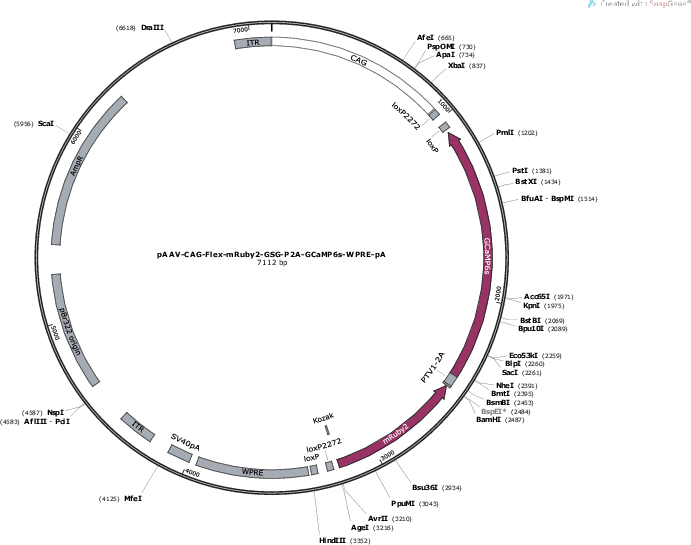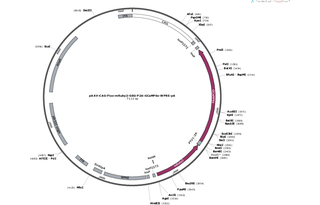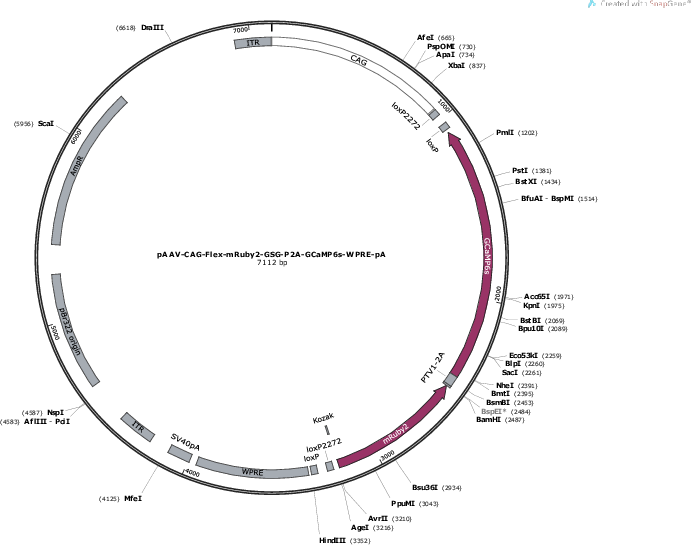-
PurposeCre-dependent bicistronic vector expressing mRuby2 and GCaMP6s from a single open reading frame.
-
Depositing Labs
-
Sequence Information
Ordering
| Item | Catalog # | Description | Quantity | Price (USD) | |
|---|---|---|---|---|---|
| Plasmid | 68717 | Standard format: Plasmid sent in bacteria as agar stab | 1 | $89 | |
| AAV1 | 68717-AAV1 | Virus (100 µL at titer ≥ 1×10¹³ vg/mL) and Plasmid. | $437 | ||
Don’t see the serotype you want?
Make a packaging request and we'll get back to you.
Please log in to submit a packaging request.
-
SerotypeSelect serotype for details See details about
-
PricingSelect serotype and quantity $ USD for preparation of µL virus + $32 USD for plasmid.
-
How this works
- Place a request for a quantity of 2 (0.2 mL), 10 (1 mL), 25 (2.5 mL), or 50 (5 mL). Our all-inclusive pricing includes DNA production and QC.
- Addgene will quickly confirm that we can produce a high-quality prep for you.
- Track your request and place an order from within your account. Payment information must be added before we can begin processing your order.
- Receive your prep in 6–9 weeks after the MTA is approved by your organization.
- Learn more about our Packaged on Request Service.
Backbone
-
Vector backbonepAAV
- Total vector size (bp) 7112
-
Vector typeAAV
Growth in Bacteria
-
Bacterial Resistance(s)Ampicillin, 100 μg/mL
-
Growth Temperature37°C
-
Growth Strain(s)Stbl3
-
Growth instructionsDue to ease of recombination, AAV and lentivirus vectors should be amplified in a recombination deficient bacteria strain such as Invitrogen's OneShot Stbl3 cells. Check for integrety of ITR sites with SmaI digest.
-
Copy numberLow Copy
Gene/Insert
-
Gene/Insert namemRuby2-P2A-GCaMP6s
-
SpeciesR. norvegicus (rat), G. gallus (chicken); A. victoria (jellyfish)
-
Insert Size (bp)2124
-
MutationCre-dependent expression from inverted open reading frame (i.e. 'FLEXED')
- Promoter CAG-FLEX
Cloning Information
- Cloning method Unknown
- 5′ sequencing primer actcagcgctgcctcagtct
- 3′ sequencing primer gtttgtacaaatgatgacagcgaag
- (Common Sequencing Primers)
Resource Information
-
Articles Citing this Plasmid
Terms and Licenses
-
Academic/Nonprofit Terms
-
Industry Terms
- Not Available to Industry
Trademarks:
- Zeocin® is an InvivoGen trademark.
Depositor Comments
mRuby2:
Article: Improving FRET dynamic range with bright green and red fluorescent proteins. Lam et al (Nat Methods. 2012 Sep 9. doi: 10.1038/nmeth.2171. PubMed)
Addgene Plasmid 40260
GCaMP6s:
Article: Ultrasensitive fluorescent proteins for imaging neuronal activity. Chen et al (Nature. 2013 Jul 18;499(7458):295-300. doi: 10.1038/nature12354. PubMed)
Addgene Plasmid 40753
Information for AAV1 (Catalog # 68717-AAV1) ( Back to top)
Purpose
Ready-to-use AAV1 particles produced from pAAV-CAG-Flex-mRuby2-GSG-P2A-GCaMP6s-WPRE-pA (#68717). In addition to the viral particles, you will also receive purified pAAV-CAG-Flex-mRuby2-GSG-P2A-GCaMP6s-WPRE-pA plasmid DNA.
CAG-driven, Cre dependent, GCaMP6s calcium sensor and bicistronic, physically separate mRuby2 expression. These AAV preparations are suitable purity for injection into animals.Delivery
- Volume 100 µL
- Titer ≥ 1×10¹³ vg/mL
- Pricing $405 USD for preparation of 100 µL virus + $32 USD for plasmid.
- Storage Store at -80℃. Thaw just before use and keep on ice.
- Shipment Viral particles are shipped frozen on dry ice. Plasmid DNA (≥ 200ng) will also be included in the shipment.
Viral Production & Use
- Packaging Plasmids encode adenoviral helper sequences and AAV rep gene, AAV1 cap gene
- Buffer PBS + 0.001% Poloxamer 188
- Serotype AAV1
- Purification Iodixanol gradient ultracentrifugation
- Reporter Gene mRuby2 (Cre-dependent)
Biosafety
Requestor is responsible for compliance with their institution's biosafety regulations. Lentivirus is generally considered BSL-2. AAV is generally considered BSL-1, but may require BSL-2 handling depending on the insert. Biosafety Guide
Terms and Licenses
-
Academic/Nonprofit Terms
-
Industry Terms
- Not Available to Industry
Viral Quality Control
- Addgene ensures high quality viral vectors by optimizing and standardizing production protocols and performing rigorous quality control (QC) (see a list of our QC assays). The specific QC assays performed varies for each viral lot. To learn which specific QC assays were performed on your lot, please contact us.
- Titer: the exact titer of your sample will be reported on the tube. The titer you see listed on this page is the guaranteed minimum titer. See how titers are measured.
Visit our viral production page for more information.
Addgene Comments
Using FLEX vectors in vivo: LoxP sites in FLEX plasmids are known to recombine during DNA amplification and viral vector production, which may result in a minority of Cre-activated (i.e., "flipped") viral vectors. Addgene has measured this occurs in 0.1-0.8% of viral particles in our typical production protocol. This can lead to a small number of cells exhibiting Cre-independent transgene expression in vivo. To address this, it is necessary to optimize the injection volume and viral titer to find the optimal AAV dosage required for Cre-dependent transgene expression and function in vivo. This may include reducing the viral particle dosage in order to reduce the likelihood of Cre-independent expression.
These plasmids were created by your colleagues. Please acknowledge the Principal Investigator, cite the article in which the plasmids were described, and include Addgene in the Materials and Methods of your future publications.
-
For your Materials & Methods section:
pAAV-CAG-Flex-mRuby2-GSG-P2A-GCaMP6s-WPRE-pA was a gift from Tobias Bonhoeffer & Mark Huebener & Tobias Rose (Addgene plasmid # 68717 ; http://n2t.net/addgene:68717 ; RRID:Addgene_68717) For viral preps, please replace (Addgene plasmid # 68717) in the above sentence with: (Addgene viral prep # 68717-AAV1) -
For your References section:
Cell-specific restoration of stimulus preference after monocular deprivation in the visual cortex. Rose T, Jaepel J, Hubener M, Bonhoeffer T. Science. 2016 Jun 10;352(6291):1319-22. doi: 10.1126/science.aad3358. 10.1126/science.aad3358 PubMed 27284193








